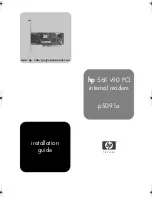
43
●
LTE
— Long Term Evolution. A set of enhancements to UMTS (moving toward 4G) that will provide
high throughput, low latency, plug and play and seamless connection to existing networks such as
GSM, cdmaOne, etc.
●
MEID
— Mobile Equipment IDentifier. A globally unique number for a physical piece of mobile station
equipment.
●
MSID
— Mobile Station IDentifier. A number for a mobile phone that identifies that phone to the
network. These numbers are carrier specific.
●
Network Technology
— The technology on which a particular network provider’s system is built; such
as GSM, HSPA, CDMA, EDGE, and EVDO.
●
Port
— A virtual data connection used by programs to exchange data. It is the endpoint in a logical
connection. The port is specified by the port number.
●
PUK code
(Pin Unlock Key) — A PUK is required when you enter an incorrect PIN 3 times. After
entering the wrong PIN 3 times, the SIM card is disabled.
●
Rev A
— CDMA EV-DO Rev. A is a leading-edge wireless technology with higher data rates and higher
system capacity. It is a fully backward compatible standard and remains interoperable with deployed
EV-DO networks and devices around the world. The increased data rates on Rev. A’s physical layer
enable richer applications and services. For more information, visit
.
●
SIM
— Subscriber Identification Module. A SIM is a card containing identification information for the
subscriber and their account. The SIM card can be moved to different devices.
●
SMS
— Short Message Service. A service for sending short messages of up to 160 (224 in 5-bit mode)
characters to mobile devices. SMS is also known as text messaging.
●
UI
— User Interface. The part of a software application or hardware device that a user sees and
interacts with.
●
USB
— Universal Serial Bus. A connection type for computing device peripherals such as a printer,
mobile modem, etc. USB connectors may be used for data transfer or charging.
●
USB Port Types
— The USB ports on computers and hubs have a rectangular Type A socket, and
peripheral devices have a cable with a Type A plug. Peripherals that do not have an attached cable
have a square Type B socket on the device and a separate cable with a Type A and Type B plug. Ports
and connectors are available in different sizes (for example, standard, mini, and micro).
●
WCDMA
— Wideband Code-Division Multiple Access. A 3G mobile wireless technology that promises
much higher data speeds to mobile and portable wireless devices. Another name for UMTS.

































